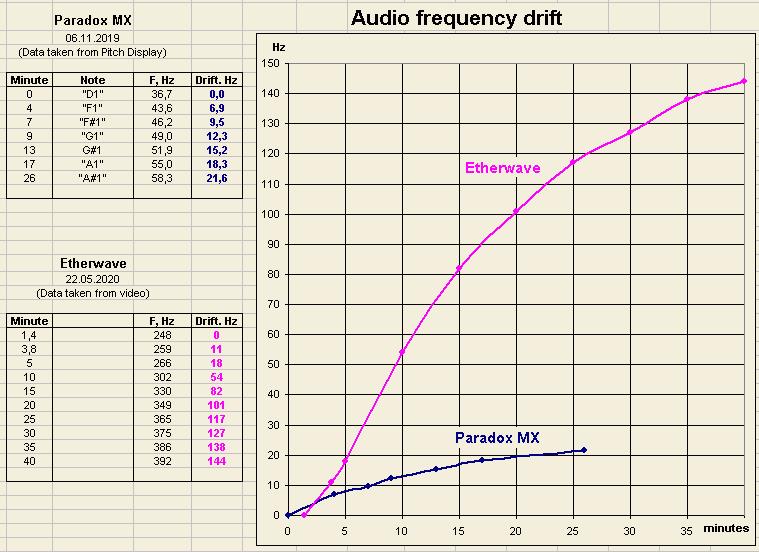In the next few days I would like to do some tests and comparisons of my Theremin with a Big Briar Etherwave. Do you have any suggestions or certain interest?
basic experiments
Can you use heterodyned audio Hz, or delta of this, as a measure of absolute drift for comparison purposes (i.e. between different types of Theremins)? I mean, maybe you can, but I'm not convinced it is a valid approach. Wouldn't absolute oscillator frequency and antenna C padding confound things? Could you adjust a given Theremin to have less drift, perhaps by tuning both pitch oscillators down? Then again, maybe this sort of drift is the only thing that really matters.
For analog theremins: if the drift is in Hz (not in music intervals) I suppose we can. According the nature of heterodyning, the drift in Hz will not depend on the current pitch, so any pitch far enough from coupling zone (bass end) can be choosen as a starting point.
But the situation is different for digital theremins. Mathematics makes them. No ideas yet.
For heterodyning theremins: The absolute drift of beat frequency will tend to be higher if a higher oscillator frequency is used, but depends not on the pitch high. Etherwave uses 285 kHz, my theremin 392 kHz.
The drift-detuning in the bass ranges would be compensated with a bigger shift in the hand position than in the higher octave range.
In the Etherwave the temperatur compensation is made by a resistor with negativ temperature coefficient. In my concept the ceramic resonator is the limiting factor for the drift effect.
Learning a lot about the Etherwave now. A first try is to calibrate the pitch range. The low beat frequencies are stable up to near zero, but look at the distorted form! Signal after DETECTOR is the pure input for post production with BRIGHTNESS und WAVEFORM. These function knobs can easily set so that the detector signal remains almost unaffected on the way to the final audio signal (see the oscillograms here). Variing this two knobs do not help at all because the input signal is already wrong.
The cause is the too heavy coupling of the filter circuits of the variable and the fixed pitch oscillator, as well known for the Etherwave. Buffering with two additional transistor stages is the common way to prevent this.
Two effects occur:
1. The timbre becomes extremely rough and
2. the linearity goes wrong due to an improperly stretching.
Now, before I go on to testing and comparing with my theremin, I want to find a minimally invasive solution for the Etherwave.
Why has Moog not made a very simple and quick modification in the Etherwaves since Melodia until today? A mystery to me. A proper reduce of the coupling leads directly to a playability of a very deep string bass. I will demonstrate it in a video next time (not sure if anyone is interested in here?).
You must be logged in to post a reply. Please log in or register for a new account.


